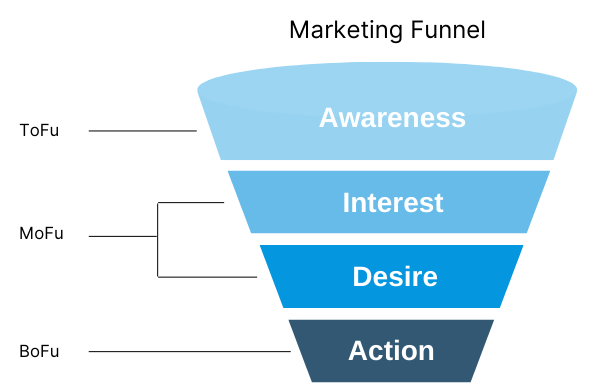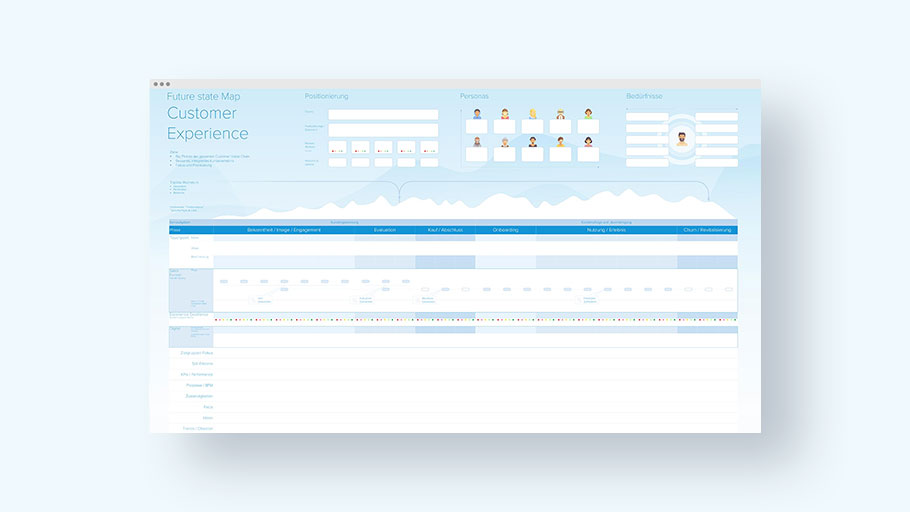2. Advantage of the Marketing Funnel
3. Sales Funnel vs. Marketing Funnel – One Funnel, Many Names
4. What is a Customer Journey?
5. What Customer Journey Models are there?
6. How does the Customer Journey differ from the Marketing Funnel?
7. How do the Customer Journey and the Marketing Funnel interact?
8. Takeaways
What is the Marketing Funnel?
As the name suggests, the marketing funnel visualisation is a funnel. It shows the individual phases of the customer’s buying process. The funnel starts with perception and ends with a concrete conversion, such as a purchase.
The three areas of a simple marketing funnel:
- Top of Funnel (ToFu): establishing initial contact with the largest possible number of potential customers. The focus is on reach and traffic.
- Middle of Funnel (MoFu): prospects are filtered out. The primary task in this phase is lead generation in order to build a relationship.
- Bottom of Funnel (BoFu): finally, this phase is about turning the leads into customers.

Advantages of the Marketing Funnel
- The principle is easy to understand and a funnel can usually be tracked well.
- The funnel helps to draw the attention of a large number of people to your company. From this, qualified leads can be generated step by step.
- From the initial mass, target groups can be gradually built up with the help of the funnel.
- The funnel shows which content potential customers need along the buying process.
- A helpful concept for marketing to specific target groups.
Sales Funnel vs. Marketing Funnel – One Funnel, Many Names
The funnel is not only used in marketing. It is also used in other areas for visualisation. Since the marketing funnel can be viewed from different business areas, there are also different names.
However, the terms sales funnel, conversion funnel and marketing funnel are all based on the same concept.
What is a Customer Journey?
The customer journey shows the customer’s journey. This ranges from the first point of contact with a company or a brand to a previously defined target action. Sometimes this is a monetary conversion such as a purchase – but this does not necessarily have to be the case. So-called micro-conversions such as subscribing to a newsletter, filling out a form or obtaining information material can also be a possible goal.
The five phases of the customer journey
The classic model of the customer journey consists of five phases:
-
- Awareness: the target group becomes aware of the product or service.
- Consideration: the target group informs itself and considers the question of whether a purchase or use is worthwhile.
- Conversion: the prospective customer becomes a buyer – the purchase is completed or the service is used.
- Retention: the customer gains experience with the product or service.
- Advocacy: the customer shares his experience.
With the help of a customer journey map, the journey can be clearly visualised from the customer’s point of view. The customer’s journey is mapped along the various phases and with all touchpoints.
It is crucial that the brand is visible and can be experienced by potential customers at every point of contact along the customer journey. If the customer’s needs are also placed at the centre, a positive customer experience can be created.
Creating a customer journey map – step by step:
- Define target group
- Identify touchpoints
- Put touchpoints into a chronological sequence
- Analyse customer satisfaction
- Create a Customer Journey Map
With the help of customer journey mapping, weak points along the journey can be uncovered and customer experiences can be optimised further and further.

What Customer Journey Models are there?
There are various models for the customer journey that follow different approaches. Most of them follow a linear or cyclical approach.
A common feature of all approaches is the starting point. A purchase decision is not made immediately. The attention of the target group must first be gained and their interest aroused. Only then can the desire for a product or service arise in the first place. Ideally, this desire then leads to a purchase. This consideration is based on the well-known AIDA model (attention, interest, desire, action).
Models:
- Classic five-phase model: the classic model divides the customer journey into the five phases of awareness, consideration, conversion, retention, and advocacy.
- Customer Journey Model by Aufgesang: Aufgesang implemented the classic customer journey model into a sales funnel and extended it with two phases.
- Messy Middle in the Customer Journey: This model assumes that the customer dwells in a state of exploration and evaluation before deciding to make a purchase.
- Consumer Decision Journey: The Decision Journey developed by the management consultancy MC Kinsey consists of only two phases – the Consideration and Purchase phases.
- Moments of Truth: The concept focuses on decisive moments in the customer journey.
- Customer Purchase Journey: This is a combination of the Moments of Truth and the Decision Journey model and includes the Awareness, Consideration, Evaluation, Purchase, and Experience phases.

Free template for optimizing the customer experience
Looking for an easy-to-use template to help you visualize and optimize your company’s customer experience? Our template offers you a simple way to display the steps and touchpoints of your customers at a glance and identify optimization potential.
How does the Customer Journey differ from the Marketing Funnel?
Probably the most important difference between the journey and the funnel is the perspective. The marketing funnel represents the contact between the company and the customer from the company’s perspective. The customer journey, on the other hand, is from the customer’s point of view.
Another difference is the length of the journey. The marketing funnel often only reaches as far as the conclusion of the purchase. The customer journey, on the other hand, takes into account the customer’s journey beyond this point. Topics such as customer retention and loyalty play an important role here.
There are also differences in the representation. While the funnel actually always runs vertically, the customer journey is often depicted horizontally, sometimes also as a vertical funnel.
How do the Customer Journey and the Marketing Funnel interact?
The combination of customer journey and marketing funnel provides a better and more comprehensive view of the customer. In other words, they enrich each other. The whole thing is well illustrated by a marketing campaign: a separate funnel is created in each phase of the customer journey and for each individual target group.
It can therefore be useful to break down the individual phases along a funnel in order to orchestrate the specific steps of the customer in the various phases across the board. The supreme discipline here is to align the journey of a specific customer target group directly with other funnels of other target groups or stakeholders and to generate an overarching organisational experience from this. This is the only way to determine the individual processes, required skills, and digital requirements across all contact points in order to make the overarching experience target image stringently tangible.
Beispiele für schlechte Customer Experience
Ganzheitliche Erfahrung
Allgemeine Kundenerfahrung
Verstehen des großen Ganzen
Beispiele für gute Customer Experience
Produkt-/dienstleistungsbezogen
Spezifischer Kundentyp
Eintauchen in Details
Takeaways
The marketing funnel and the customer journey are important tools in marketing. They help companies to better understand their customers and enable a targeted approach.
The journey takes the customer’s point of view. It shows the customer’s journey from the awareness phase to purchase and beyond. A customer journey map can be used to show this journey graphically. There are various models for depicting such a journey.
The marketing funnel shows the individual phases of the customer buying process in the form of a funnel. The goal is to lead as many people as possible through the individual phases. In the process, the number of leads decreases towards the bottom, but their quality increases. In contrast to the customer journey, the contact between the company and the customer is represented from the company’s point of view.
The combination of funnel and journey is the supreme discipline and enables a comprehensive view of the company’s own customers and other stakeholders. The structuring and visualisation of the two concepts can be designed very individually according to one’s own ideas. A general template can provide orientation and a first approach to the topic for the own company or organisation.
A CX Map for your company?
You might also be interested in
Customer Experience (CX): Definition, strategies and examples
